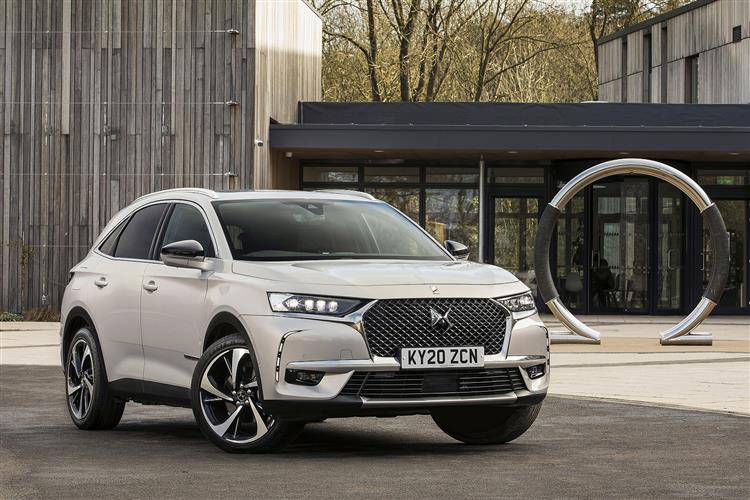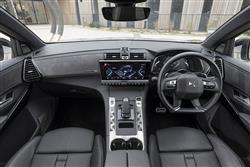How will you view?
This is a sample, and will stop after 30 seconds.
BACK TO BATTERY (some text hidden) SECTIONED_mid_ds7crossbacketense4x4_2020
By Jonathan Crouch
Introductionword count: 75
Launched in 2019, the DS 7 Crossback E-TENSE 4x4 represented this luxury French brand's more distinctive take on what a 'D'-segment luxury plug-in SUV should be. It can take you over 30 miles without emitting any CO2, manage 128mpg, sprint to sixty in six and a half seconds and even extricate you from a muddy carpark on your annual trip to Glastonbury. In short, it's a bit special - and is styled that way too.
Modelsword count: 7
5dr SUV (1.6 THP petrol Hybrid 4x4)
Historyword count: 210
Looking at the various electrified alternatives the current car-buying customer now has on offer, it's sometimes hard not to think that the plug-in hybrid option is arguably the best. Mild hybrid tech doesn't make much difference to overall efficiency figures. And full-electric models still carry the scourge of 'range anxiety'. So being able to plug in to extend the range of a conventional petrol engine with a lithium-ion battery charge makes as much sense now as it did when we first saw plug-in models hit the market, nearly a decade ago. When it comes to SUVs, you'll generally need a mid-sized or larger one to be able to specify plug-in technology. Back in 2019, the Stellantis Group made a number of the various 'C'-segment SUVs that could offer it - cars like hybrid versions of the Peugeot 3008, the Citroen C5 Aircross and the Vauxhall Grandland X. Plus the conglomerate also used the same tech for a slightly larger, more luxurious model that sat in the 'D'-segment just above - this car, the DS 7 Crossback E-TENSE 4x4. It sold in its original form until late-2022, when it was facelifted and renamed simply as the 'DS 7'. It's the 2017-2022-era DS 7 Crossback E-TENSE model though, we look at here.
What You Getword count: 521
Visual differentiation points setting this E-TENSE variant apart from more conventional models in the range are few. There's special badging. And this electrified variant could be had in an exclusive 'Pearl Crystal' paint shade. That's about it. As with the conventional versions of this model, the styling is distinctive, with lovely detailing, particularly at the front end, the look of which was inspired by the avant garde 'DS Divine' concept car of 2014. We particularly like these exotically intricate 'DS Active Vision' LED headlamps, which emit a purple light when the car is unlocked, before pivoting by 180-degrees - in a nod to the original Fifties DS model's clever swivelling front lights Moving to the side, there are the usual roof rails and the normal mid-level crease that flows just below the glass house; this one loses itself in the back door before reappearing to emphasise the rear haunches. Large 19 or 20-inch wheel rims are standardised on E-TENSE models. Possibly our favourite perspective is the one that's usually most forgettable when it comes to cars of this kind - the rear. The wrap-around tailgate is embellished with what the brand liked to call 'hypnotic' rear lights', super-slim 3D strips with scrolling indicators, each lamp a full LED made up of illuminated scales. Of course, what's more important is what you can't see. This model sits on a longer version of the Stellantis Group's EMP2 platform than did the conglomerate's equivalent Peugeot 3008, Vauxhall Grandland X and Citroen C5 Aircross plug-in SUVs. The brand saved its boldest flourishes though, for the interior, which was intended to be an extrovert celebration of everything that's cutting edge in French fashion. Alcantara, open-pore wood inlays and leather feature in copious quantities appropriate to the Parisian-themed trim package you've chosen. The 'E' embossed onto the gearbox control was apparently a nod to the DS E-TENSE electric Concept Car Even the techno-fest that must rather incongruously fit in around all of this frippery couldn't escape the Louis Vuitton treatment. So the super-sized 12-inch infotainment touchscreen that struggles to fit in at the top of the centre stack gets a strange barrel-style crystal-like centre volume dial. And, like the 12-inch instrument binnacle TFT monitor, can be configured via a 'DS Sensorial Drive' feature to display its information in shades of either Cashmere or Titanium. Rear seat space is good; even for a six-footer sitting behind quite a lanky front seat occupant, the legroom on offer should be quite sufficient. The backrest reclines from 23 to 32-degrees in rake - electrically on the top model - which is nice for longer journeys. Unfortunately though, there's no sliding mechanism for the seat base, which is a pity. This SUV is a 5-seater only. Out back, the boot of this electrified version is exactly the same size as that of a conventionally-engined five-seat model, 555-litres in size. Which is massively better than the restricted 395-litres you'd get in a directly comparable Audi Q5 TFSIe. If you need more room and use the cargo sidewall catches to push forward the 60:40-split seat, you can free up 1,752-litres of total fresh air.
To see the full road test text contact us on 0330 0020 227
Pictures (high res disabled)

.jpg)
|
.jpg)
|
.jpg)
| |||
.jpg)
|
.jpg)
|

|
Scoring (subset of scores)
Category: Crossover or SUV 4x4s
| Performance | |
| Handling | |
| Comfort | |
| Space | |
| Styling, Build, Value, Equipment, Depreciation, Handling, Insurance and Total scores are available with our full data feed. | |



